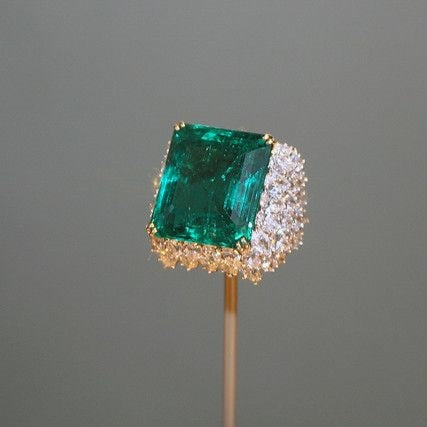The Colombian emerald of the Andes
In the mystical landscape of the Andean mountains of Muzo, Colombia, a treasure of nature is hidden: the Emerald of the Andes.
This emerald, majestic in its greatness and exquisite in its color, has forged a legend that resonates over the centuries, making it one of the most famous emeralds of ancient times.
Therefore, in order for you to know the history of this mythical gem, we have written this entry with the most important details of its history, background, and where it is today.
Magnificence in Green
With an astonishing weight of around 1,930 carats, the Emerald of the Andes is a symphony of intense green, a marvel that dazzles with its unique glow. Nearly 400 grams of pure elegance, this colossal gem is a testament to the amazing creation of nature.
Extracted from the depths of the Muzo mines in the 16th century, the emerald has become an emblem of Colombia's geological wealth.
Although the Emerald of the Andes is known mainly for its impressive size and connection to historical events, the specific characteristics of this beautiful gem have been the subject of debate due to the lack of detailed information and accurate records.
Overall, however, an emerald of such renown is expected to exhibit certain characteristics associated with this green gemstone.
- Color: The Emerald of the Andes, being one of the largest and most valuable, would presumably exhibit a dazzling green color.
- Colossal Size: The most outstanding feature of the Emerald of the Andes is its amazing size, weighing approximately 1,930 carats. This exceptional magnitude makes it one of the largest known emeralds.
- Origin of Muzo, Colombia: The origin of an emerald can be crucial to its value. The Emerald of the Andes originated in the region of Muzo, Colombia, known for producing high quality emeralds and distinctive color.
The Enigma of History
The narrative surrounding the Emerald of the Andes is woven with threads of myth and legend. They say that this unique jewel belonged to the last Inca emperor, Atahualpa, who, in a desperate attempt to secure his freedom from the Spanish conquerors led by Francisco Pizarro, offered this monumental jewel.
Despite his noble gesture, Atahualpa's execution left the emerald in the hands of conquerors, marking the beginning of a story full of mysteries and tragedies. Because of this their background is uncertain, it is not known who their owners were during the story and what their current fate is.
A Disappeared Treasure
Although the Emerald of the Andes is not currently in the public eye, its history continues to whisper in the shadows of the past. After changing hands over the centuries and being part of the European royal collections, the emerald plunged into the mystery, disappearing at some point in history. His current whereabouts remain in the dark, contributing to the enigma aura surrounding this unique jewel.
Paula A. Bonilla
Social communicator and journalist from Sergio Arboleda University in Colombia. She is also a jeweler and is passionate about constantly learning about precious gems and national high jewelry.
Currently, she is working for one of Bogotá's most important jewelry stores, Emerald by Love. This jewelry store has over 40 years of experience and has 2 physical branches in the capital city of Colombia, located in the city center.


